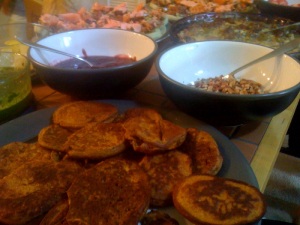Ted Slanker sells happy, grass-fed, free-ranging farm animals–not just cows, but chickens and goats and lambs and … you get the point. His prices on these are reasonable, so if you can afford to buy in bulk and have the freezer/fridge space, I’d highly recommend buying this man’s meats. The man also sends out monthly newsletters filled with the grouchy rantings of an old man, but they are as true as anything I’ve read.
I’m excerpting his last newsletter below, but it’s really long, so first I wanted to slip in a line about
mooJesus!. It’s a
church-run dairy in Seguin that sells RAW MILK. We know dairy is a big no-no, but the verdict is out on the effects of RAW DAIRY on your body. If you want to go that route, mooJesus! sells milk, cheese, cream, butter … all the good stuff you can’t eat if you’re strictly Paleo. They also sell free-range chicken, beef, etc. Check out the site, if nothing else it’s great for a laugh …
mooJesus!
Back to Mr. Slanker, here’s an excerpt from his latest newsletter:
Some Customers Just Don’t Get it Yet
Naturally I eat grass-fed meats. That’s because when it comes to feeding my body my primary goal is to eat for optimal body function. Yet even though grass-fed meats are very important they are not THE answer to optimizing one’s health. That’s why I’m very strict regarding ALL the foods I eat. I wasn’t always that way. It was only about 12 years ago I started learning about what is and is not proper food. That’s when I first started learning about what the world’s most sophisticated nutritional scientists had been reporting on in peer-reviewed studies for years (commencing about 30 years ago). Their messages were relatively simple. Basically, what they were saying was that one must eat like a caveman to eat a perfectly balanced diet.
It’s pretty logical if you think about it. The caveman (prehistoric man) ate the same way for about four million years. Since the “composition” of our modern day bodies is virtually identical in every respect with that of the early caveman our bodies are optimally geared for exactly his same nutrient intake. Prior to man’s invention of grain farming (a mere 10,000 years ago) his foundation food had always been riveted to the green leaf just like all other members of the animal kingdom. (That’s why grass-fed meats are so important today.) Also, most other entrees on the caveman menu were vegetables, mostly salad type stuff that he plucked from the surface. (More green leaves.) And contrary to the popular beliefs of most modern nutritionists fruits and nuts were not staple foods because they were always seasonal treats.
The Concocting of Food
When thinking in terms of four million years, man first started concocting his foods yesterday – about 10,000 years ago when he started grain farming. And when I say “concocting” I mean “concocting.” The growing of grain is a major undertaking that starts with the creation of an artificial environment where only one species of annual grass is grown on a plot of land. To do that the land must be prepared (dug up) and planted with the seeds saved back from the prior year’s harvest. The annual grass that germinates from the planted seeds is then protected from grazing animals as it grows. When it’s about four or five months old the grass matures and produces seeds. After the seeds have cured there is a rush to harvest them before they drop to the ground. The whole effort concludes with the storing of the seeds so they can be eaten out of season.
There is no question that grain farming was an amazing invention for concocting a food that could be stored. Unfortunately the first concocted food of modern man, if you want to call it a food, is what I call The Atomic Bomb of the American Food System.
During the thousands of years that followed the invention of grain farming man expanded his food concocting efforts. As he did, he changed his diet (nutrient intake) away from that of a caveman. The consequences of his newly concocted foods quickly lead to more and more body failures as the balance of nutrients in the diet deviated from the balance found in the green leaf. Today we refer to all body failures as chronic diseases. And because our modern food system is based on grain, chronic diseases and the resulting health care costs are a monumental and universal problem in America.
Don’t Get It
Many of our customers still don’t get it when it comes to eating correctly. They may favor grass-fed meats, but they still slip and slide in all other aspects of their diet. All animal bodies (humans are part of the animal kingdom) must follow the green leaf for optimal body function. There are no exceptions to the rule. Man Is an Extension of the Leafy, Green Plant. Any deviation from the caveman diet results in a skewing of the basic nutrients away from what all animal bodies require. On the other hand, when one eats like a caveman he gets exactly 100% of his body’s nutrient needs in perfect balance. In other words, when it comes to a nutrient flow the body is expecting no more or no less than what a caveman ate.
The most damaging foods are grains (rice, oats, wheat, corn, barley, rye, and most other cured seeds of grasses and legumes) and high glycemic foods. (The glycemic index ranks foods based on their immediate effect on blood sugar levels.) High glycemic foods are those that convert to sugar rapidly and give the body a sugar jolt. Foods that have a low glycemic index will have little affect on the body’s sugar levels. High glycemic foods include baked potatoes, most fruit juices and soft drinks, candy, ice cream, pineapple, watermelon, raisins, pastries and breads, and the list is nearly endless. I consider all foods with an index above 40 to be on the high side. Many in the food trade say 60 is the break point. (I’ll explain why I stick with 40 in my discussion below on high glycemic foods.)
Grain and Grain-Based Foods
Let’s begin our examination of body debilitating foods by focusing first on grain. Grain, the seed of an annual grass plant, has fat and chemical profiles that differ radically from that of green leaves. Maybe the worst nutritional component in grain is the balance of essential fats. The Omega-6 and Omega-3 fats are essential for animal bodies – which means that for the most part animal bodies won’t make them. They get them by eating them. Yet the balance of these particular fats in cell membranes plays a critical role in body function. That’s why essential fats, which are sourced only from the foods we eat, can be very destructive when out of balance and very positive for body function (both mental and physical) when in balance.
Since the fat profiles of grain differs significantly from the fat profiles in green leaves – and it was the green leaf that for all of time determined the balance of essential fats in all animals – it doesn’t take a genius to figure out that eating grain, grain-based foods, and grain-fed livestock products will be detrimental to body function.
What happens when essential Omega-6 and Omega-3 fats are out of balance in the membranes of cells in animal bodies? Simple, bodies fail to function correctly both mentally (brains are 60% fat!) and physically. That goes for every animal and that means every human too. Sure you can point to this fellow here or there who eats lots of grain and doesn’t appear to be having any health issues. But in time, all grain eaters hit the wall with body failures. How so? Well, every chronic disease you can mention is a body failure. It can range from toenail fungus to Alzheimer’s Disease.
Not only is grain associated with all chronic diseases, but because the nutrients in grain hinder and can actually destroy a body’s immune system, all grain-eaters are far more susceptible to infections from viruses and bacteria. But that’s not all. Anemic bodies are also negatively impacted by a whole host of natural organic substances including such things as pollen!
For a fact, no grain eaters are immune to the damaging aspects of the nutrient profiles in grain. ALL grain eaters will have some form of body failure in time even if it’s nothing more than under performance compared to the health and performance of eating like a caveman.
Fungi in Bodies
Before you roll your eyes and pass over this commentary on fungus, maybe you should know that the Center for Disease Control has 2,500 citations on their web site for fungal, 2,580 for fungi, and 1,320 for fungus. Many of the articles refer to fungal infestations that occur inside animal (and human) bodies.
For starters, grains are universally contaminated with fungi. But that shouldn’t surprise us since there are more than 75,000 named fungi species naturally occurring in the environment. (It is estimated that there may actually be about one million more fungi species that are not yet named.) Grain is not the only fungi host. You’ve seen mold growing on fruit in the stores, on bread and potatoes, on the walls in homes, in air conditioning ducts, on the ground, and so forth. Therefore it should be no surprise to you that anyone can get fungal infestations within their bodies from the foods they eat, the air they breathe, and the ground and things they touch.
For many years I have personally dealt with a fungal infestation in my hand. Many ranchers and farmers get my particular fungal infestation from handling hay, digging in the dirt, and doing the regular Farmer John stuff. So, I have first hand (play on words!) experience to pass on here and now. I don’t even remember for how long it was that my hand had a rash on it that would actually weep at times just like a bad case of poison oak. I had tired various ointments and such, but they would only subdue the “rash,” never end it.
Then about eight years ago I ran into Doug Kaufmann (http://www.knowthecause.com/) and Dr. David Holland (http://www.thinkfungus.com). Slowly, and I mean slowly, I started learning about fungi and the mycotoxins they produce. The whole concept of fungal infestations in a body and what that meant was so foreign to me that it was hard to comprehend at first. But it finally sank in especially as I grew to understand the “rash on my hand.”
For much more about mycotoxins [myco = fungus (Greek) toxins = poisons (Latin)] go to http://en.wikipedia.org/wiki/Mycotoxin. In case you need some inspiration here’s one quote off that Web page referring to mycotoxins and their impact: Some of the health effects found in animals and humans include death, identifiable diseases or health problems, weakened immune systems without specificity to a toxin, and as allergens or irritants.
If that doesn’t perk your interest maybe this fact should: 100% naturally produced organic mycotoxins are the greatest source of chemical contamination in our foods. Mycotoxins can appear in the food chain as a result of fungal infection of crops, either by being eaten directly by humans, or by being used as livestock feed. Mycotoxins greatly resist decomposition or being broken down in digestion, so they remain in the food chain in meat and dairy products. Even temperature treatments, such as cooking and freezing, do not destroy mycotoxins. The quote is from Wikipedia, the free Web-based encyclopedia.
When you have fungi in your body (and everybody does) they spew out mycotoxins shortly after you eat grain, grain-based foods, grain-fed livestock products, and high glycemic foods. Depending on the fungi species, genetic predispositions, and the integrity of one’s immune system the mycotoxins impact people in different ways. Some people experience major mental problems, which is why it is estimated that 28% to 30% of the adult population of the United States has either a mental or addictive disorder. That’s about 58 million people! It is estimated that over 20% of the nation’s children have mental disorders. These numbers are from Mental Health: A Report of the Surgeon General.
For much more on how your brain is impacted by the foods you eat go to: Brain Function is Unequivocally Food Dependent.
If the shocking level of mental disease in the general population of grain-fed Americans isn’t bad enough, you can add chronic ailments such as diabetes, obesity, osteoporosis, heart disease, cancer (heart disease and cancer accounted for 48.5% of all deaths in 2007), arthritis, asthma, hay fever, allergies, gout, autoimmune disorders, thyroditis, chronic fatigue syndrome, multiple sclerosis, systemic lupus erythmematosus, and nearly all of the other chronic diseases doctors treat with drugs and operations instead of diet!
Interestingly nearly ALL chronic diseases can be tied to the grain-based diet and fungal infestations. So, in addition to offering healthy meats we also offer a limited line of Health Supplements
that can help minimize the negative impact of fungal infestations. Psyllium Husks absorb mycotoxins and carry them out of the body. And supplements such as Olive Leaf Extract and Thorne Research – Undecyn are known for their antifungal properties.
High Glycemic Foods
A discussion about high and low glycemic foods brings me back to the fungus on my hand. I have learned the hard way that every time I deviate from a strict caveman diet, the area on my hand where my rash used to fester on a daily basis will flare up once again. First the area will itch, then the skin will dry out and get rough, and in a worst case scenario it will start to weep resulting in small open sores. In most cases my dietary deviations are unintentional. In other words I try a food product that I believe will be okay and it’s not okay. In most other cases it’s because I was a guest at a social function and ate some of the “forbidden foods” to be polite.
Amazingly, it may take anywhere from a few hours down to a few minutes for me to have a reaction from high glycemic foods. I know this because I have learned to “listen” to my body. In other words, I remember what I eat and when I ate it so I can reflect on my diet in response to how my body is functioning. Body function includes the mental monitoring of joint pain, intestinal health, my mental attitude, heart beat and blood pressure, weight, energy, and the rash on my hand.
As mentioned earlier, I consider foods with a Glycemic Index (GI) over 40 as being “high.” Finding the GI of any food product is rather easy so I always check when I don’t know. My favorite method is to go to an Internet search engine and type in the name of the food product plus “glycemic index.” For instance “cucumber glycemic index.” Then CLICK. In an instance I have my answer. Fans of fruit, wild rice, fruit juices, potatoes, Gatorade, and other so called healthy foods will be surprised to learn they are ingesting damaging levels of sugar on a daily basis. High GI foods along with grain accounts for most of the anxiety, fear, rage, mood swings, and other emotional disturbances that plague so many people today. The sugar shots also cause joint pain, heart disease, cancers, intestinal problems, obesity, and the list of ailments go on and on.
Two Strikes You’re Out!
Grain, grain-based foods, grain-fed livestock products and high glycemic foods are the underlying cause for nearly 100% of all chronic diseases. In addition, because grain-based foods damage immune systems many more people than would normally be the case fall ill and also die from diseases brought on by viruses and bacteria. So I look at the grain-based foods and high glycemic foods as being “two strikes you’re out.” And in this game, life plays for keeps. So as far as I’m concerned, the bad foods aren’t worth fooling around with under any circumstances.
If you are interested in optimizing your mental and physical health you do not have a wide variety of food options. Eating grass-fed meats along with grain-based and high glycemic foods is not going to do you much good. In fact the better meats may do nothing for you. That’s because all Americans already have an grossly imbalanced nutrient profile which they acquired from ingesting the wrong foods over their entire lives. Therefore their immune systems are already compromised plus they have fungal infestations. Consequently it takes only a little grain-based and/or high glycemic foods to keep their bodies on tilt. So even if they eat grass-fed meats till the cows come home their dietary deviations from the Diet of Man will have thrown enough gas on the fire to create every chronic disease flare-up they would have had without the grass-fed meats.
This is why for me there is absolutely no grain, grain-based foods, grain-fed livestock products, and high glycemic foods in my diet. I spent over 50 years eating the wrong foods and was lucky enough to eventually learn what is and is not proper food. My body (both physically and mentally) has responded so positively to the Diet of Man that in no way do I want to jeopardize a good thing.
Toeing the Line
The change to eating exclusively the Diet of Man calls for mostly grass-fed meats and veggies. Oh yes, there is also some fruits and nuts. But fruits and nuts are seasonal and ancient fruits were mostly tart – unlike today! Of course the greatest burden on the modern-day caveman is establishing a ready supply of highly diversified grass-fed meats. For the most part veggies are available no matter where you are. This is why in my home I always make it a point to have a good stash of a wide variety of meats at all times. Since you know about Slanker’s Grass-Fed Meats you can do the same. Therefore the greatest problem any one of us should have with eating correctly arises when we’re invited out to someone’s home or to a restaurant.
When I have to hit a restaurant there are times when the only entree on the menu that’s fit to eat is the salad. So that’s all I eat and my biggest challenge then is picking a salad dressing! When dining at a restaurant with friends, they are usually not offended when you order just a salad. But when invited to their home it’s a different story. That’s when compromise comes into play and in order to not make waves about the eating habits of others one keeps any and all deviations very moderate.
No Deviations
Knowing that my body can react negatively within 15 minutes after eating “forbidden” foods, gives me all the inspiration I need to avoid improper foods at every opportunity. Since all human bodies are very sensitive to the foods ingested, that means if you want optimal body function you too must be very strict.
I eat about two pounds or more of grass-fed meat a day. I eat piles of veggies. Yes, I have urges for my old grain-based food favorites of years gone by. But I resist them with an iron will and the knowledge that improper foods are poisons. So once again I urge every one of you to take an inventory of the foods you eat. Don’t bother with nutrition labels, read the ingredient labels. Those are the only labels that count. Then respect your body by toeing the line.
Your body will thank you for it in the long run.
So there you have it. Crossfitters aren’t the only crazies…
Read Full Post »


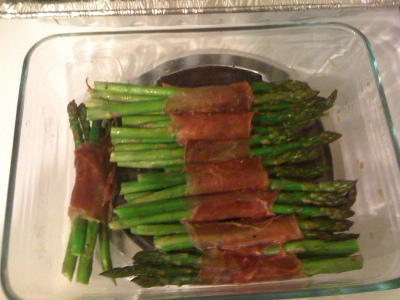
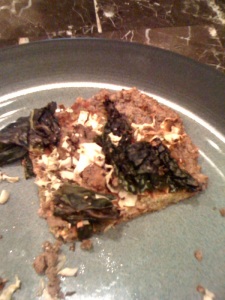

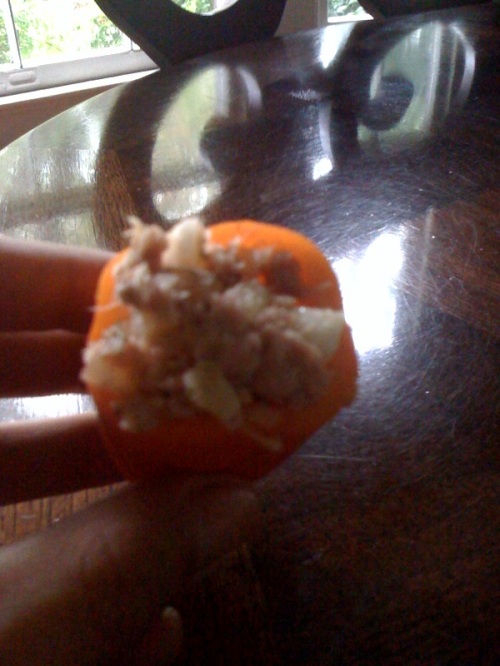
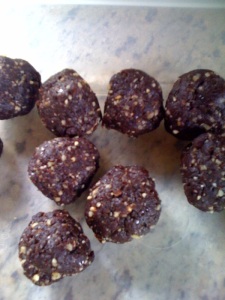
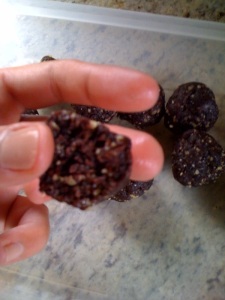
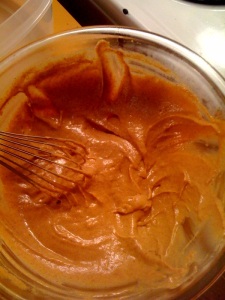 This is really the easiest recipe ever. Step 1: Put all ingredients in a bowl. Step 2: Mix thoroughly. I used a whisk, and at first I didn’t think it was going to work. All of a sudden, everything came together to form a thick, creamy batter. See?
This is really the easiest recipe ever. Step 1: Put all ingredients in a bowl. Step 2: Mix thoroughly. I used a whisk, and at first I didn’t think it was going to work. All of a sudden, everything came together to form a thick, creamy batter. See?